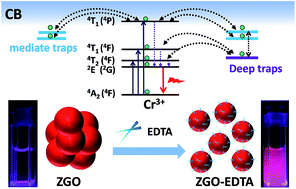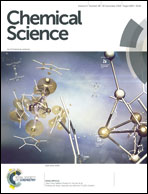EDTA etching: a simple way for regulating the traps, size and aqueous-dispersibility of Cr3+-doped zinc gallate†‡
Abstract
Traps, size and aqueous-dispersibility are the most important parameters that affect the features and applications of persistent luminescent nanoparticles (PLNPs). However, simultaneous controlling of these parameters is rather difficult and has not been reported yet. We present the first exploration on adjusting the traps, size and aqueous-dispersibility of PLNPs via simple ethylenediaminetetraacetate (EDTA) etching. Cr0.0043+:ZnGa2O4 (ZGO) was used as the PLNP model. EDTA etching of the sintered ZGO results in effective reduction of the size and great improvement in the aqueous-dispersibility. In addition, EDTA etching alters the density of mediate traps and generates new deep traps, thus achieving the massive production of (ultra)small ZGO–EDTA with fine aqueous-dispersibility, suitable mediate/deep traps and superlong bright afterglows (51 days). As EDTA can interact with most metals, this simple EDTA etching strategy is prospectively amenable to other PLNPs, and the resulting PLNPs–EDTA have wide applications in both biological field and information storage.

- This article is part of the themed collection: Celebrating 100 Years of Chemistry at Nankai University


 Please wait while we load your content...
Please wait while we load your content...